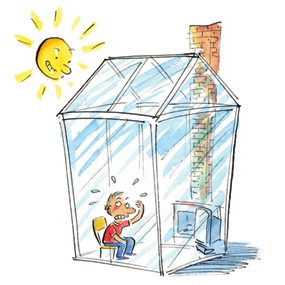
Tip 1: Plan your project and get bids well in advance
Have you ever tried to find a contractor in March to start your new three-season porch that you want completed by Mother’s Day? It’ll cost more than if you’d found a contractor in January. Most contractors plan out months ahead and don’t want to disrupt their schedules. They’ll shoot you a high bid, because they really don’t want to fit you in … unless you pay a high rate.
Most building trades have busy seasons and slow seasons. Plan ahead, and you’ll get more competitive bids during the slow seasons. Best times to schedule:
- roofing—cold or rainy months
- indoor renovations—winter or during rainy months
- heating—late summer, before fall
- air conditioning—late winter or early spring
- chimney cleaning— anytime except fall!
- project design (architects)—fall and winter
Tip 2: Pay extra for energy-saving features
With energy prices rising, many contractors are offering energy efficiency upgrades (at an additional price). These might include higher-efficiency windows; guaranteed air sealing; extra-thick insulation; and higher-efficiency heating, cooling or other appliances. If they don’t offer this, you can ask what additional measures they (or you) can take to improve your home’s energy performance. Then compare the estimated energy savings with the cost of each upgrade. A payback period of seven to 10 years is good. (Simple payback is the time it takes for the savings to equal the original cost.) Keep in mind that upgrades done during the remodeling process always cost less than upgrades added later.
Tip 3: Hire an architect or designer for at least an initial sketch
The most expensive mistake you can make is to build an addition or remodel a room that you don’t like when it’s finished. Professional design help during the planning stage helps you tailor the space to fit. Sometimes it takes only one or two key details to make that room special. Most architects and designers will walk you through the initial planning for a modest fee. Gather lots of visual material to illustrate your ideas. And be sure you’re on the same page as your spouse! Be prepared to do some legwork after going through these home improvement tips.
Tip 4: Pitch in and do parts of the project yourself
Doing the entire project yourself is by far the best way to save. But if you don’t have the time or skills, your part-time sweat equity can reduce costs. Consider taking on such labor-intensive jobs as demolition, moving materials, digging, cleaning up the job site after work, sanding trim or painting. Coordinate the jobs with the contractor in advance and agree on their value. Beware! Once you commit yourself, make sure to complete the work in a timely way. Tardiness can throw off the construction schedule and cost you more in the long run!
Tip 5: Plan for future upgrades if you can’t afford them now
You don’t have to wait until you can build your dream addition all at once. You can get started now and gradually add as your finances allow. But work from a master plan so you don’t have to go back and tear out or upgrade what you’ve already done.
For example, consider:
- an electrical service with capacity for the future addition, workshop or hot tub
- in-the-wall wiring for electronics in every room or a future home theater
- rough plumbing for a future half bath or hot tub
- wiring for future lighting fixtures
- rough framing for future doors or windows
- French doors that open to a future deck.
Tip 6: Compare the price of remodeling with the cost of buying new
Your house is your most important investment as well as the place you call home. Although you may love your house and neighborhood, check how much your addition would add to the value of your home. Creating a luxury home in a modest neighborhood may not make financial sense. A real estate agent or home appraiser can make a close estimate. If you can’t recoup at least 75 percent of the cost when you sell, at least consider the advantages of buying another house with the space or features you need. It may well be a better investment to move rather than to add on.
Tip 7: Shop for materials yourself
You won’t save much by trying to stockpile lumber, drywall, electrical wiring or other basic building materials. But when it comes to the finish materials—carpeting, appliances, faucets, countertops, light fixtures—your own footwork will pay off. Not only do you get exactly what you want, but you also can find bargains, especially if you start collecting these items well in advance. You can even plan to reuse a stylish old stove, distressed hardwood flooring or other items that add a creative touch to a room. But clear your decisions with your contractor; installation costs might be higher for unusual requests.
Tip 8: Don’t overdo windows and skylights
Big windows and skylights can have a spectacular effect in a new addition, making it feel bright and cheery and offering great views. But more is not always better. Not only are windows and skylights expensive, but even energy-efficient ones will sharply increase your heating and cooling bills. Large skylights can make a room feel like a furnace in the summer! You may have to replace your air conditioner, heat pump or furnace with a larger one. Or perhaps add units to keep the room comfortable.
Tip 9: Avoid moving the plumbing or changing the foundation
You can’t always avoid it, but any alteration to these two systems typically adds thousands to a remodeling project. Neither is simple. New plumbing often requires breaking into walls and floors; resizing lines to meet newer plumbing codes; and replacing old, out-of-date pipes. New foundations usually require excavation, concrete and other heavy, expensive work. The price jumps whenever you add these two items, so ask yourself if you really need to move the kitchen sink during a kitchen remodel, or if you really need the extra space in a bathroom bump-out.
Tip 10: Order over the internet
Can’t find a nice-looking low-voltage light fixture at a nearby home center? The Internet puts a wide selection of products at your fingertips. Even better, it gives you access to hard-to-find specialty items at competitive prices. Often you can save 40 to 50 percent over the list price.







